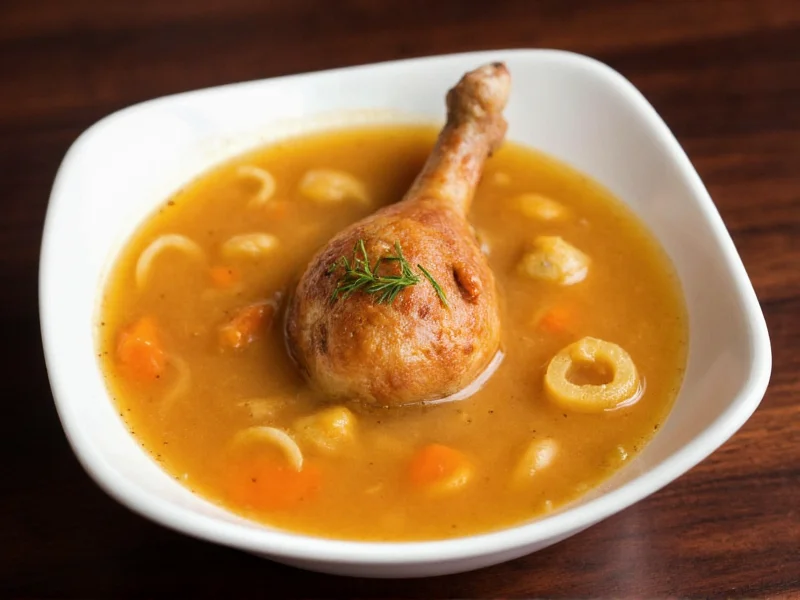Chicken drumstick soup represents one of the most flavorful and economical approaches to homemade broth preparation. Unlike breast meat, drumsticks contain higher concentrations of collagen, gelatin, and bone marrow that transform into rich, velvety broth during simmering. This easy chicken drumstick soup recipe leverages these natural advantages while providing complete nutritional benefits often missing in store-bought alternatives.
Why Drumsticks Create Superior Soup
Drumsticks outperform other chicken cuts for soup making due to three critical factors. First, their higher bone-to-meat ratio releases more gelatin during cooking, creating that coveted silky texture professional chefs prize. Second, the dark meat maintains moisture better during extended cooking times. Third, the connective tissues break down completely after 90 minutes of simmering, enriching the broth with nutrients without leaving unpleasant textures.
Traditional Chicken Drumstick Soup Recipe
This authentic preparation method yields approximately 8 servings and requires minimal active preparation time. The best chicken drumstick soup for cold weather balances simplicity with deep flavor development.
| Ingredient | Quantity | Preparation Notes |
|---|---|---|
| Chicken drumsticks | 6-8 pieces | Rinse and pat dry before use |
| Yellow onions | 2 medium | Quartered with skins on for color |
| Carrots | 3 large | Peeled and cut into 1-inch chunks |
| Celery ribs | 3 stalks | Include leaves for extra flavor |
| Garlic cloves | 4 | Smashed, not minced |
| Fresh thyme | 4 sprigs | Or 1 tsp dried thyme |
| Bay leaves | 2 | Remove before serving |
| Apple cider vinegar | 2 tbsp | Helps extract minerals from bones |
| Water | 12 cups | Cold, filtered preferred |
| Sea salt | To taste | Add only after cooking completes |
Step-by-Step Preparation Guide
Mastering how to make flavorful chicken drumstick soup requires attention to timing and temperature. Follow these professional techniques for optimal results:
- Dry roast bones (optional but recommended): Place drumsticks on baking sheet and roast at 400°F for 20 minutes until golden brown. This step enhances flavor through the Maillard reaction.
- Cold water start: Always begin with cold water to gradually extract flavors. Place drumsticks in large stockpot with cold water.
- Skim impurities: As water heats to just below boiling (180-200°F), foam will rise. Skim carefully with spoon for first 20 minutes.
- Add acidifier: Stir in apple cider vinegar once water reaches 160°F to help extract minerals from bones.
- Simmer gently: Maintain temperature between 180-200°F (just below boiling) for 1.5-3 hours. Vigorous boiling creates cloudy broth.
- Add vegetables: Introduce chopped vegetables during last 45 minutes of cooking to preserve texture and color.
- Final seasoning: Add salt only after cooking completes, as concentration changes during reduction.
Slow Cooker Chicken Drumstick Soup Instructions
For those seeking slow cooker chicken drumstick soup instructions, follow these adapted steps:
- Place roasted drumsticks in slow cooker with cold water
- Add vinegar and set to low for 8-10 hours (do not exceed 12 hours)
- Add vegetables during final 2 hours of cooking
- Strain broth through fine mesh sieve before serving
- Remove meat from bones, shred, and return to broth
Maximizing Flavor and Nutrition
Professional chefs employ several techniques when preparing healthy chicken drumstick soup with vegetables. The collagen content in drumstick-based broths provides significant joint health benefits while creating that luxurious mouthfeel. For maximum nutritional value:
- Include vegetable peels (onion skins, carrot tops) during cooking for additional nutrients, removing before serving
- Maintain consistent low temperature rather than rapid boiling
- Cook for minimum 90 minutes to fully extract gelatin from connective tissues
- Add fresh herbs during last 15 minutes to preserve volatile compounds
Storage and Reheating Guidelines
Proper storage preserves both flavor and safety of your traditional chicken drumstick soup preparation. Follow these food safety guidelines:
- Cool broth rapidly by placing pot in ice water bath
- Refrigerate within 2 hours of cooking completion
- Store in airtight containers for up to 5 days
- Freeze in portion-sized containers for up to 6 months
- Reheat only the portion needed to maintain quality
Common Mistakes to Avoid
Many home cooks make these critical errors when attempting chicken drumstick soup cooking time and temperature preparation:
- Boiling vigorously instead of gentle simmering (creates cloudy, bitter broth)
- Adding salt too early (concentrates during cooking)
- Overcooking vegetables (becomes mushy and loses nutrients)
- Skipping the skimming step (results in impure flavor)
- Using hot water start (causes proteins to coagulate improperly)











 浙公网安备
33010002000092号
浙公网安备
33010002000092号 浙B2-20120091-4
浙B2-20120091-4